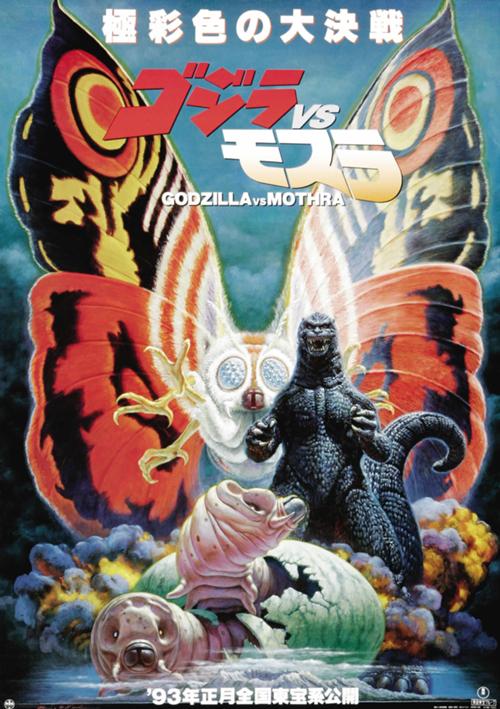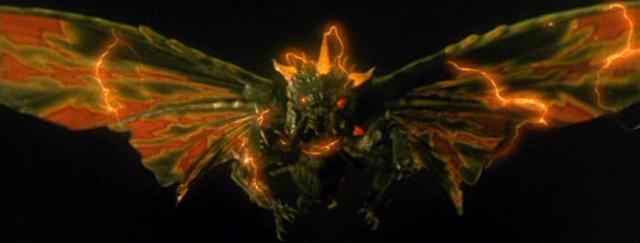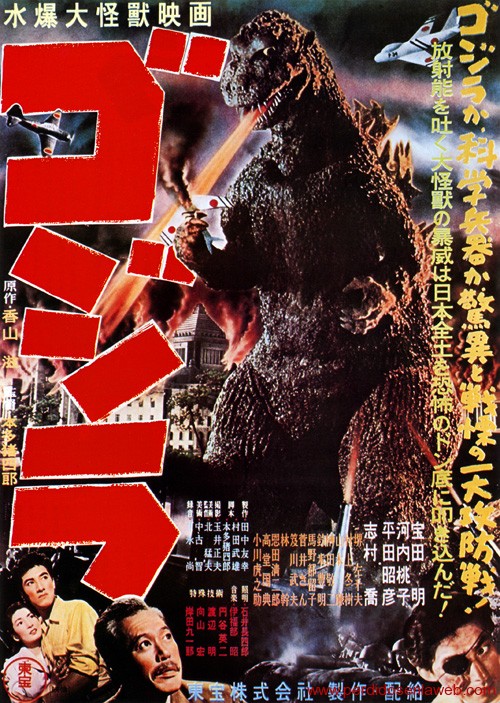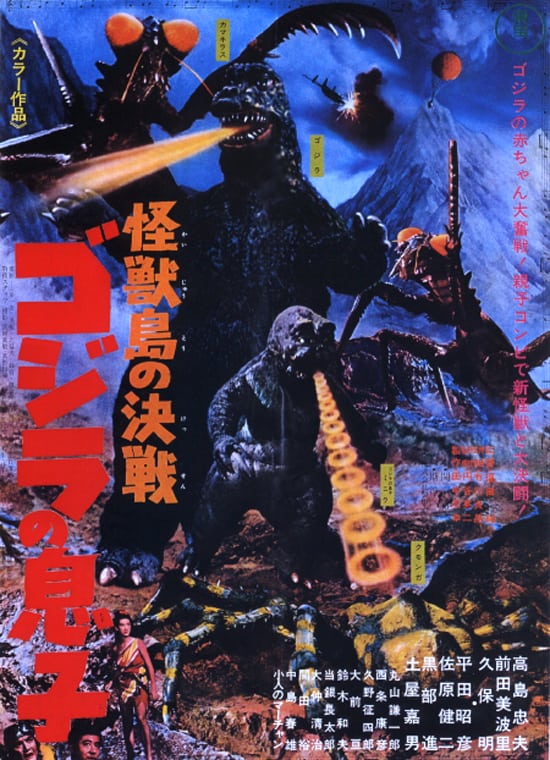Godzilla Vs Mothra (1992)
Directed by: Takao Okawara
Written by: Kazuki Omori
Starring: Saburo Shinoda, Satomi Kobayashi, Takehiro Murata, Tetsuya Bessho
HCF REWIND NO.163. GODZILLA VS MOTHRA AKA GOJIRA TAI MOSURA [Japan 1992]
AVAILABLE ON DVD
RUNNING TIME: 101 min
FEATURED MONSTERS: GODZILLA, MOTHRA, BATTRA
REVIEWED BY: Dr Lenera, Official HCF Critic
A large meteor hurtles towards earth and lands in the ocean, causing a huge typhoon and awakening Godzilla. Meanwhile thief Takuya Fujita steals an ancient artefact and is caught, but is asked to join an expedition, which includes his ex-wife, to Infant Island financed by the greedy Marutomo company. They find a huge egg and also two tiny women called the Cosmos, who tell them the egg belongs to Earth’s guardian Mothra. They are the only two survivors of an ancient alien race that tried to control the earth’s climate. In return, the earth created the monster Battra, who destroyed all but two of the Cosmos before being defeated by Mothra. The expedition decides to ferry Mothra’s egg back with them, but Battra has also been awoken….
Though it features the same title monster and thinks up a new origin for him, Godzilla Vs King Ghidorah is certainly not a remake of Ghidorah The Three-Headed Monster. Godzilla Vs Mothra though is another matter. It’s often considered a remake of Mothra Vs Godzilla, but it also remakes Mothra. I like it almost as much as those two films. It suffers from a very confused and messy script that badly needed tidying up, but it totally delivers in the action stakes, is the fastest paced film in the series since Godzilla Vs Megalon, and has the best special effects of all the film up to the 2000’s. It also has a beguiling innocence and even beauty about it, while criticisms of its environmentalist agenda, while perhaps justified in terms of how clumsily it’s often spouted out [almost all the characters say something about humans destroying the earth] seemingly ignore the fact that that a great deal of anime did much the same thing. There’s a lovely Japanese feel to this film, perhaps more so than any film in the series, even the two films it remakes. This is in part because Godzilla Vs King Ghidorah didn’t get a US release and producer Tomoyuki Tanaka and co. found themselves courting a Japanese audience only.
You will recall that a project entitled Mothra Vs Bagan, with the giant moth battling a shape-changing creature, almost went into production after Godzilla Vs Biollante. What is cool about this treatment is that the action would not only have taken place in Japan but Borneo, Singapore and Bangladesh. Though the original plan was to follow-up Godzilla Vs King Ghidorah with Ghidorah’s Counterattack, a poll revealed that Mothra was the most popular monster among women, who comprised the largest section of the Japanese film-going audience, so a new film with Mothra it became. The first treatment, written by three including director Kazuki Omori, was called Godzilla Vs Gigamoth, Gigamoth being an a mutated version of Mothra. The silly story included a hero who falls in love with a woman who is twenty centimeters tall! Omori combined elements of this and his Mothra Vs Bagan script into the final draft, though Takao Okawara was picked to replace Omori as director. Early during production the Godzilla suit was stolen and they therefore had to build a new suit, though the previous one was eventually found by a terrified old woman in a lake. The climax was rewritten, the original idea being for Mothra to be killed and be resurrected in the next film as Mechamothra, but even the new ending, which originally showed the sunken Cosmos city, was scaled down. Godzilla Vs Mothra brought in huge audiences and became the only Godzilla film to be the top-grossing domestic release in Japan. The reason it wasn’t the actual top-grossing release? A certain film called Jurassic Park, the power of American blockbusters even breaking into the monopolistic power wielded by Toho and Shochiku Studios over Japanese cinemas.
So let’s get the bad out of the way first and, yes, Omori’s screenplay is badly muddled. After some so-so early scenes which in two particular moments seem like Indiana Jones parodies, our explorers find Mothra’s egg and the tiny twin Fairies, now called the Cosmos, launch into a very long-winded explanation of all this stuff that happened in the distant past involving aliens controlling the balance of nature, machines, monsters and a huge flood. It contrasts badly with the elegant simplicity in Ishiro Honda’s two Mothra films and the idea that the Cosmos and, I suppose, Mothra too, are aliens lessens our sympathy for them. Then again, the roles the monsters play are inconsistent. If Battra is supposed to be the self-preservation instinct of the earth, why does he automatically start wrecking everything, and as for Godzilla, he’s barely in the story, just turning up every now and again to smash things and fight whichever monster he comes across. At the end of the film, we learn that Battra awoke to save earth from a huge meteorite, but because Godzilla kills Battra, Mothra decides to take Battra’s place. Mothra’s self-sacrifice would have been more touching if we had learnt of the meteorite earlier in the film and been constantly aware of its threat.
Still, there’s even more monster footage than before, with Battra’s attack on Nagoya occurring before even half an hour has passed. The models are almost as detailed as Eiji Tsuburaya’s and the matting far superior. Soon after this we get some fighting between Battra and the just-hatched caterpillar Mothra, and then Godzilla and Battra go at it underwater, interrupted by the hoary device of an underwater volcano. It is after this though that the film really shines, recreating and bettering scenes from Mothra as her tiny guardians are kidnapped and she decides to rescue them. Mothra ploughs through everything in her way like an enormous runaway train in an even more convincing and spectacular manner than in 1960, while her transformation into her moth form has a great sense of wonder about it and is rather beautiful to behold, aided immensely by Akira Ifukube’s gorgeous music. Especially nice is the way the spectators are lit up by the brightness of the emerging creature. Godzilla gets to wreck some more destruction before the three monsters engage in a three-way battle. Again, it’s a much slower affair than your average Showa battle, and relies a little too much on beams being fired, but is very visually appealing, this one really benefiting from being staged at night, the brightness of the monsters especially Mothra lighting up the surroundings, and it has the odd good old bit of silliness like Mothra dropping a ferris wheel on Godzilla’s head.
The keen-eyed can spot that the new Godzilla suit flattens the head and makes the eyes slightly yellow, but it’s barely noticeable. Both the caterpillar and moth forms of Mothra look better than their previous incarnations. The differences are minimal, but the moth version is much brighter and looks dazzling: yes, he slightly resembles a fluffy toy, but that’s clearly the idea in a film which is clearly meant to be appealing to children as well as adults, it even having a young girl, Takuya’s daughter, in many scenes. The only flaw in Mothra’s design is that the legs don’t nervously move as in Tsuburaya’s version. Battra, who possesses a Baragon-like ability to tunnel underground, first looks like a cross between a caterpillar and Megalon, then a giant fly with some almost mechanical-like qualities. He’s impressive in both forms. Koichi Kawakita’s special effects are superb throughout and an effort has been made to make them visually pleasing too. Godzilla’s emergence from a volcano sees Kawakita use the opportunity to re-do and improve on a similar moment in Godzilla Vs Biollante, and it’s a spectacular sight, the pyrotechnics lighting up the night sky gloriously. I’ve spent so much time talking about other things that I’ve yet to mention the human side of the story, but the transformative journey of Fujita Tezuka, who begins the film caring neither about plundering ruins nor paying his ex-wife Masako alimony, into becoming a nicer person is a pleasing one. The scenes between him and his ex-wife are nicely played by Tetsuya Bessho, perhaps the best of the Heisei series heroes, and Satomi Kobayashi.
Megumi Odaki again turns up as Miki Saegusa, the telepathic woman who has a link with Godzilla, and again has nothing to do, while her organisation seems to move with each film. Also returning is Shoji Kobayashi as the government official Ruzo Dobashi, but more interesting is Akira Takarada, star of the first ever Godzilla and several sequels, returning to the series – well it would be if he was given more to do than look miserable and watch the monsters on a big screen. Akira Ifukube’s score again mostly rehashes old themes, but his new arrangement of the Song Of Mothra, which now becomes virtually the main theme of the score, is gorgeous and lush, its end title incarnation truly his loveliest piece of Toho music. Mothra’s theme is now a combination of this and his theme from Mothra Vs Godzilla, while Godzilla’s theme remains exactly the same as before and you get to briefly hear the ‘island’ theme and the march from The War Of The Gargantuas again too. Battra gets a new theme. It’s notable how Ifukube’s scoring of the battle scenes has more gaps without music now, but then he was 78 when he scored this film! Godzilla Vs Mothra seems very much like a film made by committee, with things put in to try to please everyone, but every now and again this can result in good, and, despite its poor script, there’s something rather magical, even mystical, about this installment. When young Midori looks up at Mothra’s metamorphosis into a glorious moth up with awe and wonder and says: “it’s beautiful”, the film really speaks to the child in us with unashamed directness.
Rating: 

















Be the first to comment